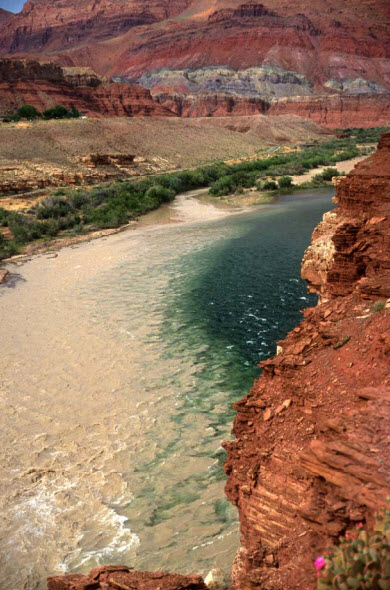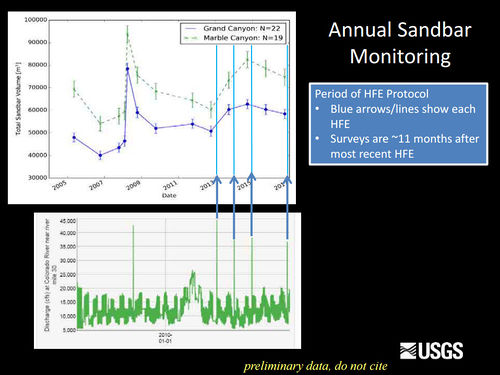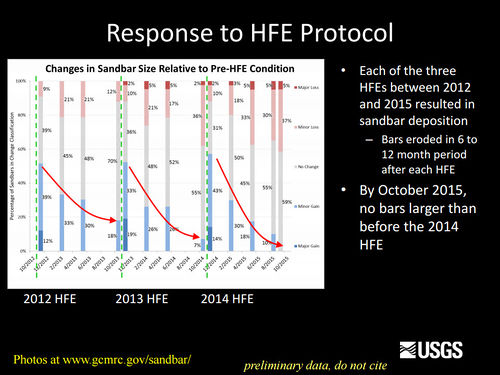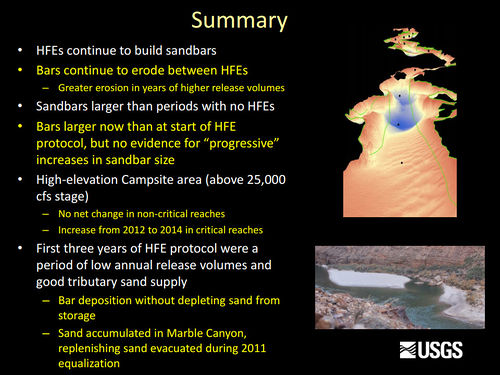|
|
| Line 160: |
Line 160: |
| | | | |
| | '''2020''' | | '''2020''' |
| | + | *[https://doi.org/10.1130/B35642.1 Chapman, K.A., Best, R.J., Smith, M.E., Mueller, E.R., Grams, P.E., and Parnell, R.A., 2020, Estimating the contribution of tributary sand inputs to controlled flood deposits for sandbar restoration using elemental tracers, Colorado River, Grand Canyon National Park, Arizona: GSA Bulletin ] |
| | *[https://www.usbr.gov/uc/progact/amp/twg/2020-01-13-twg-meeting/20200113-AnnualReportingMeeting-ProjectBEffectsDamReleaseSedimentStorageSandbarDynamics-Presentation-508-UCRO.pdf Project B: Effects of dam releases on in-channel sediment storage and sandbar dynamics ] | | *[https://www.usbr.gov/uc/progact/amp/twg/2020-01-13-twg-meeting/20200113-AnnualReportingMeeting-ProjectBEffectsDamReleaseSedimentStorageSandbarDynamics-Presentation-508-UCRO.pdf Project B: Effects of dam releases on in-channel sediment storage and sandbar dynamics ] |
| | *[https://doi.org/10.1029/2019WR025883 Ashley et al., 2020, Estimating bedload from suspended load and water discharge in sand bed rivers: Water Resources Research.] | | *[https://doi.org/10.1029/2019WR025883 Ashley et al., 2020, Estimating bedload from suspended load and water discharge in sand bed rivers: Water Resources Research.] |
 The Paria River flowing into the mainstem Colorado River
|
Erosion of sandbars (beaches) along the Colorado River in Grand Canyon was first reported in the early 1970s, approximately 10 years after completion of Glen Canyon Dam. Since then, scientific studies have been conducted to monitor changes in sandbars and changes in the amount of sand stored on the bed of the river. One of the outcomes of these studies has been the implementation of flow experiments intended to rebuild eroded sandbars, especially by the release of controlled floods, also called High Flow Experiments, or HFEs, from Glen Canyon Dam. The sediment and geomorphology projects at Grand Canyon Monitoring and Research Center include the collection and processing of data to provide information needed to conduct controlled floods and to evaluate the outcome of each controlled flood and the long-term effects of controlled floods and normal dam operations on sediment-related resources. [1]
Beginning in 1998, recreational campsite area has also been measured on a subset of the sandbar monitoring sites. Campsite areas are defined as areas that are flat (less than 8 degree slope), smooth (not rocky), and clear of dense vegetation. Monitoring data show that vegetation expansion and sandbar erosion/deposition contribute to reductions in campsite area.
Increase and retain fine sediment volume, area, and distribution in
the Glen, Marble, and Grand Canyon reaches above the elevation of the
average base flow for ecological, cultural, and recreational purposes.
High elevation open riparian sediment deposits along the Colorado River in sufficient volume, area, and distribution so as to provide habitat to sustain native biota and desired ecosystem processes
• Nearshore habitats for native fish
• Marsh and riparian habitat for fish (food chain maintenance)
• Cultural resource preservation
• Maintenance of camping beaches
|
Updates
|
|
|
Sediment transport and river discharge
|
|
When the discharge of the Colorado River was lower than about 9,000 ft3/s, sand accumulated in the reach in Marble and upper Grand Canyons. At discharges higher than about 9,000 ft3/s, however, sand-transport rates at the Grand Canyon gaging station generally equaled those at the Lees Ferry gaging station, and at discharges higher than about 16,000 ft3/s, sand-transport rates at the Grand Canyon gaging station generally either equaled or exceeded those at the Lees Ferry gaging station. Thus, at discharges greater than about 9,000 ft3/s, sand was either conveyed through or eroded from the reach in Marble and upper Grand Canyons.
As discharges less than 9,000 ft3/s became less common, the discharge of the river became progressively more conducive to the conveyance of sand through or the erosion of sand from Marble and upper Grand Canyons. [2]
|
|
Links and Information
|
|
|
|
|
|
|
Sediment Gages
|
- Water Holes Canyon above the mouth
- Paria River near Kanab, UT
- Paria River at Lees Ferry, AZ
- Colorado River at Lees Ferry
- Badger Creek below highway 89A near Vermillion Cliffs, AZ
- Tanner Wash below highway 89A near Bitter Springs, AZ
- House Rock Wash above Emmett Wash near Cliff Dwellers, AZ
- North Canyon near Cliff Dwellers, AZ
- Shinumo Wash in Twentynine Mile Canyon near Cedar Ridge, AZ
- Colorado River near river mile 30
- Colorado River above Little Colorado River near Desert View, AZ
- Moenkopi Wash near Cameron, AZ
- Little Colorado River at Grand Falls, AZ
- Little Colorado River at Cameron, AZ
- Little Colorado River near Cameron, AZ
- Little Colorado River above the mouth near Desert View, AZ
- Colorado River near Grand Canyon, AZ
- Bright Angel Creek near Grand Canyon, AZ
- Shinumo Creek
- Kanab Creek above the mouth near Supai, AZ
- Havasu Creek above the mouth near Supai, AZ
- Colorado River above National Canyon near Supai, AZ
- Colorado River above Diamond Creek near Peach Springs, AZ
|
Sand Mass Balance Reaches in Grand Canyon
|
|
|
Presentations and Papers
|
|
2020
- Chapman, K.A., Best, R.J., Smith, M.E., Mueller, E.R., Grams, P.E., and Parnell, R.A., 2020, Estimating the contribution of tributary sand inputs to controlled flood deposits for sandbar restoration using elemental tracers, Colorado River, Grand Canyon National Park, Arizona: GSA Bulletin
- Project B: Effects of dam releases on in-channel sediment storage and sandbar dynamics
- Ashley et al., 2020, Estimating bedload from suspended load and water discharge in sand bed rivers: Water Resources Research.
- Geomorphic Change and Biogeomorphic Feedbacks in the Little Colorado River, Arizona
2019
2018
- Sand tells a story
- Sankey et al., 2018, Sand classifications along the Colorado River in Grand Canyon derived from 2002, 2009, and 2013 high-resolution multispectral airborne imagery: U.S. Geological Survey data release
- GCMRC Science Updates PPT
- Hadley et al., 2018, Quantifying geomorphic and vegetation change at sandbar campsites in response to flow regulation and controlled floods, Grand Canyon National Park, Arizona: River Research and Applications
- Key drivers of sand transport and storage in the Colorado River Ecosystem PPT
- Voichick, N. et al., 2018, Technical note--False low turbidity readings during high suspended-sediment concentrations: Hydrology and Earth System Sciences
- Grams et al., 2018, Automated remote cameras for monitoring alluvial sandbars on the Colorado River in Grand Canyon, Arizona: Open-File Report
2017
- Chapman, K., 2017, Determining the tributary sediment contribution to experimental flood deposits on the Colorado River in Marble Canyon, Grand Canyon, Arizona: Flagstaff, Northern Arizona University, MS thesis
- Hamill, D., 2017, Quantifying riverbed sediment using recreational-grade side scan sonar: Logan, Utah State University, MS thesis
- Buscombe et al., 2017, Compositional signatures in acoustic backscatter over vegetated and unvegetated mixed sand-gravel riverbeds: Journal of Geophysical Research: Earth Surface
- Griffiths and Topping, 2017, Importance of measuring discharge and sediment transport in lesser tributaries when closing sediment budgets: Geomorphology
- Kaplinski et al. 2017. Channel mapping river miles 29–62 of the Colorado River in Grand Canyon National Park, Arizona, May 2009: U.S. Geological Survey Open-File Report 2017–1030
- Project 1: Streamflow, Water Quality, Sediment Transport, and Sand Budgets in the Colorado River Ecosystem
- Project 2: Hydrologic Change and the Geomorphic Transformation of the Little Colorado River: Implications for Sediment Delivery to the Grand Canyon
- Sandbars and Sediment Storage in Marble and Grand Canyons: Response to Recent High-flow Experiments and Long-term Trends
2016
- Topping et al. 2016. Long-term continuous acoustical suspended-sediment measurements in rivers — Theory, application, bias, and error: U.S. Geological Survey Professional Paper 1823
- Sandbar Modeling Project Update
- Status of Sediment Resources – August 2016
- Grand Canyon Monitoring and Research Center Science Updates and PPT (BO Compliance, Trout Updates, Green Sunfish, Fisheries PEP, Partners in Science)
- Observations of sand dune migration on the Colorado River in Grand Canyon using high-resolution multibeam bathymetry
- Project 2: Streamflow, Water Quality, Sediment Transport, and Sand Budgets in the Colorado River Ecosystem
- Sandbars and Sediment Storage in Marble and Grand Canyons: Response to Recent high-flow Experiments and Long-Term Trends
2015
- Grams et al. 2015. Building Sandbars in the Grand Canyon, EOS, Trans. Am. Geophys. Union
- Alvarez. 2015. Turbulence, Sediment Transport, Erosion, and Sandbar Beach Failure Processes in Grand Canyon. Ph.D. Dissertation, Arizona State University, Tempe, AZ
- GCMRC Science Update - Sediment
- GCMRC Science Update - Sediment
- Updates on 2014 HFE, Paria sediment inputs, and sediment mass balance
- Glen Canyon Tailwater Fishery “Integrating Fish and Channel Mapping”
- GCMRC’s Online Mapping and GIS Resources
- Streamflow, Water Quality, and Sediment Transport in the Colorado River Ecosystem
- Sandbars and Sediment Storage in Marble and Grand Canyons: Response to Recent High-flow Experiments and Long-term Trends
2014
2013
2012
2011
2010
- Wright, S.A., and Grams, P.E., 2010, Evaluation of Water Year 2011 Glen Canyon Dam flow release scenarios on downstream sand storage along the Colorado River in Arizona: U.S. Geological Survey Open-File Report 2010-1133
- Update on Water Quality and 2010 Sand Input
- Grand Canyon Monitoring and Research Updates and the Following Open File Reports: 1) Evaluation of Water Year 2011 Glen Canyon Dam Flow Release Scenarios on Downstream Sand Storage Along the Colorado River in Arizona, and 2) An Approach to Modeling Sediment Budgets in Supply-limited Rivers
- Report on Sediment Modeling to Support Development of 2011 Hydrograph
- Update on 2010 Sediment Inputs
- Temperature Control Device and Sediment Augmentation Report
- TWG Chair Temperature Control Device/Sediment Augmentation
- Minutes from June 21, 2010, TWG Webinar/Conference Call with Memo from John Hamill to Shane Capron dated May 17, 2010, Subject: TWG and stakeholder requests for GCMRC to evaluate the effects of various dam operation scenarios on sediment storage and loss in the Grand Canyon with Open File Report 2010-1133
- Mechanics and Modeling of Flow, Sediment Transport and Morphologic Change in Riverine Lateral Separation Zones
- Sediment and Temperature Modeling Update PPT as presented at January 2010 Annual Reporting Meeting
- AIF: Temperature Control Device and Sediment Augmentation and PPT
2009
2003
1999
1988
|
Other Stuff
|
Flash Flood videos
|
|



